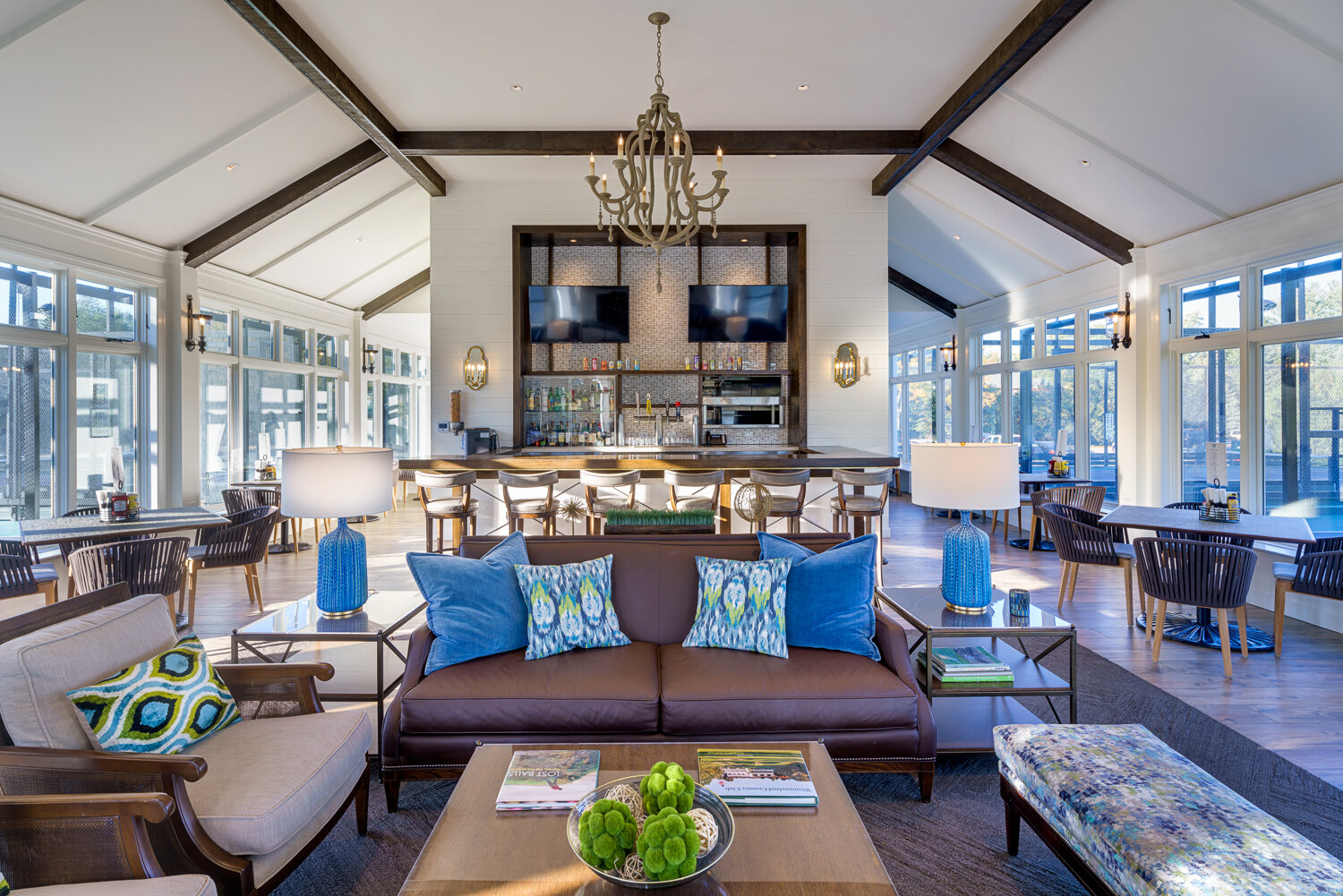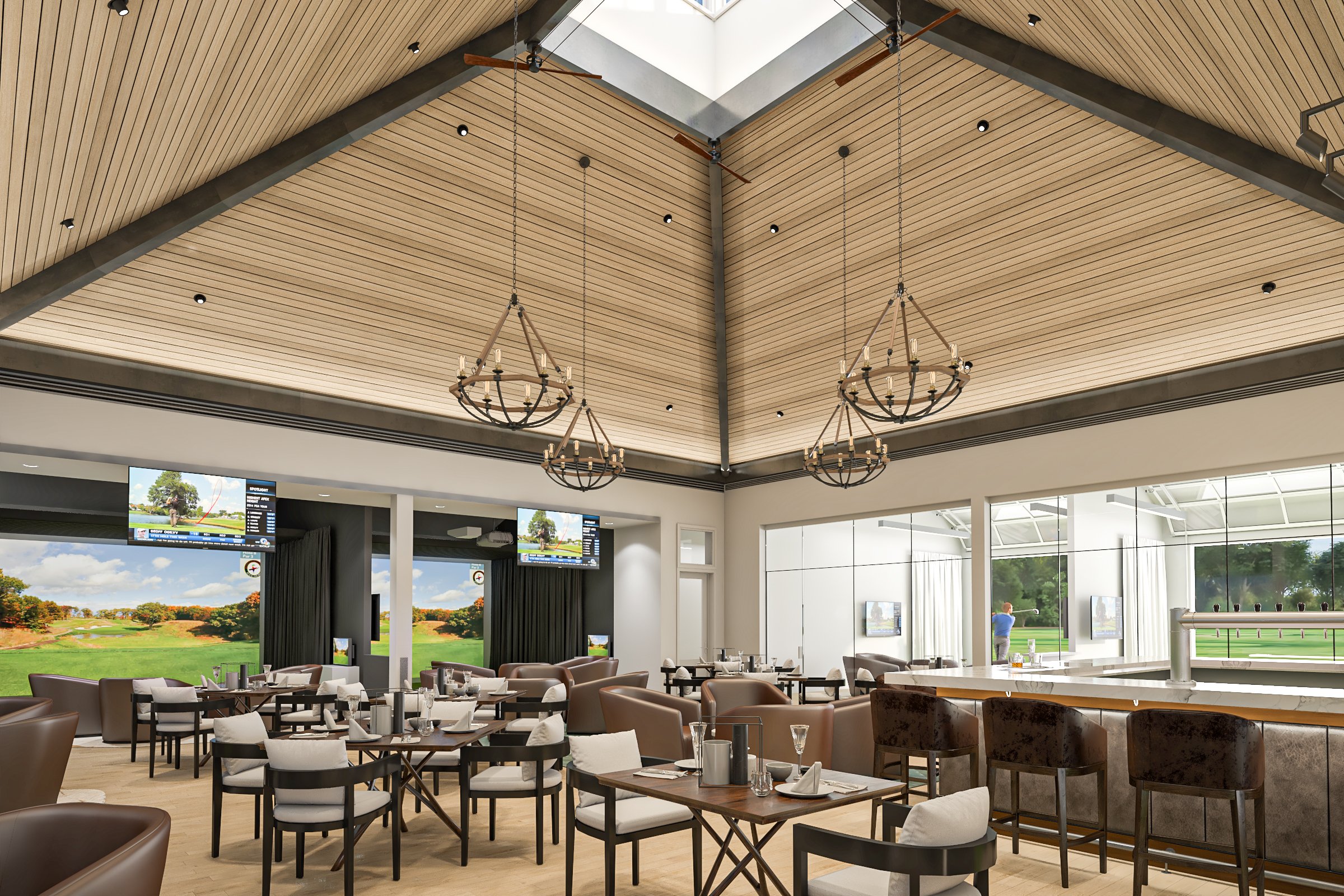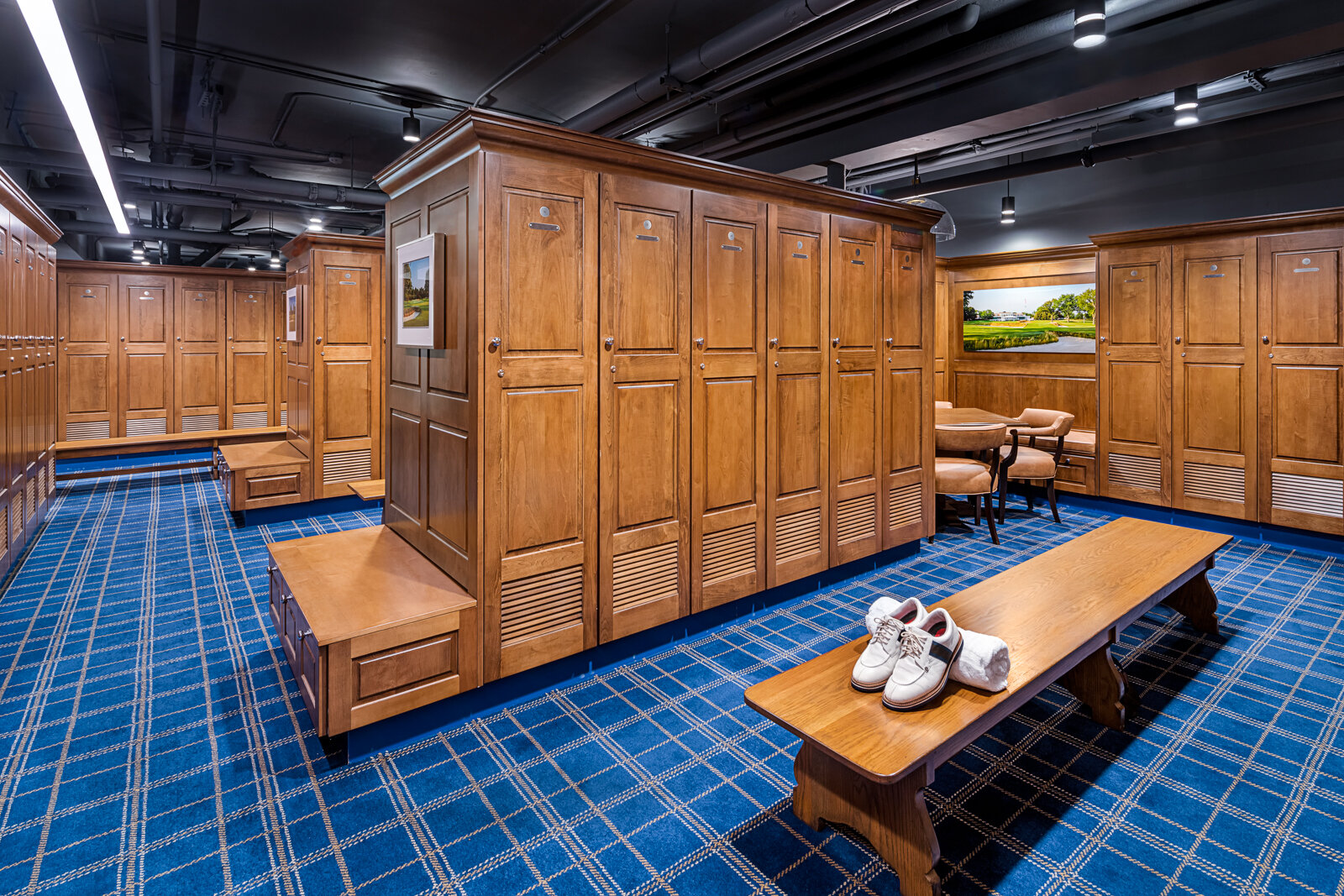Thoughts from Jon Talty AIA and Jason Mould on the state of the private club landscape, what’s changing, and what it’s like to work with OKW.
Click here to download this article as a PDF.
North Shore Country Club, photograph by Bruce Van Inwegen
REFLECTING ON THE PAST
When OKW began working with country clubs in Chicagoland nearly forty years ago, the expectations of membership were very different. For many people, it was enough to have access to a well-manicured golf course, a private dining space, and little else. Merely being a member of a private club was a privilege in and of itself, a marker of status that placed you in rarefied air.
“There are far more options today for leisure and family time,” Jon Talty AIA remarks. “This isn’t your father’s club anymore. Members want an experience, which is different from what it used to be.”
North Shore Country Club, photograph by Wayne Cable
Jon is OKW’s CEO and an influential voice in the design of Chicagoland’s clubs since 1990. He understands that although being a club member is still a marker of status, several meaningful cultural shifts have taken place since the 1980s that have forced clubs to adapt. The most significant of these changes involves the role that clubs now play in their members’ lives.
It has been said that a club is an extension of its members’ homes. Jason Mould, a project architect at OKW who has worked on eight clubs in just four years, argues that they fulfill a much bigger role now. “You want it to function almost as a resort,” he says. “Members want options, from what activities to do to what kind of dining environment suits them for the day.” Precisely because of the sheer volume of things to do, clubs today need to be as good as a restaurant, a bar, or any other option you can find in an urban or suburban environment.
Hinsdale Golf Club, photograph by Wayne Cable
Of course, not all clubs are the same. Every major decision about whether to update or overhaul the member experience has to consider the club’s culture and brand. OKW makes sure to develop a strong sense of this brand, which includes the makeup of the club’s current members, its aspirations, its mission, and the type of people they want to entice into membership.
That said, there are a few trends that we’re seeing cropping up across the country.
“It’s incredibly rewarding to see 300 families enjoying the work you’ve done.”
Jon Talty AIA
CEO & Chairman
WHAT’S HAPPENING TODAY?
“More people want to be outside,” Jon says, “and it has very little to do with covid-related fears of contagion. Clubs have learned this and are creating amenities to make outdoor activities and gatherings more comfortable.” Outdoor space has become much more valuable as are the spaces in between the club’s offerings (e.g., the path to the tennis courts, the areas just outside the paddle hut). How those spaces are occupied and served is far more important now than it has ever been.
Serving the outdoors comes with its challenges in the Midwest, where the cold winter months often keep many members indoors and in their own homes. Clubs want to discourage that by positioning themselves as year-round environments.
“These places are beautiful,” Jason says. “Why not be closer to that beauty, even in winter?”
Ruth Lake Country Club, photograph by Bruce Van Inwegen
Hinsdale Golf Club, photograph by Wayne Cable
Of course, it’s not easy to pull members out of their homes when it’s below freezing. That’s where Jon argues that there must be a nexus, something around which winter-time activities can revolve. For many clubs, the most logical option is paddle tennis. As it has always been a winter sport, it can serve as a jumping-off point for additional activities.
It’s part of a larger trend, given how much paddle huts have grown. What began as utilitarian structures that rarely exceeded 1,000 SF with a TV and a service bar are now nearly thrice the size with full kitchens and additional amenities. Jason is working on a Chicagoland club that is looking to upgrade their paddle facility for this exact purpose. “Instead of calling it a paddle hut, we’re calling it their winter campus.” This is because the facility is located next to a popular sledding hill and will also house golf simulators and a bar.
Westmoreland Country Club, photograph by Wayne Cable
Golf simulators are important because the sport continues to be the dominant draw for most clubs. Since 2020, golf has only risen in popularity. The National Club Association called it the largest growing sport (as opposed to pickleball, which has been growing the fastest). Providing members with simulators and indoor teaching facilities can extend the sport’s viability past the most clement months, especially since the rise of remote work has opened up time for many people to enjoy the golf course.
But has it opened up space within clubs for its members to work?
“Like a lot of things,” Jon says, “it depends on the culture of the club.” Many clubs already have conference rooms that can function for board meetings or business retreats, but on a reservation basis and not as a dedicated workspace for any member. However, some clubs see working as something they’d rather discourage, preferring to exist as an oasis, a getaway from the complications of everyday life.
Racine Country Club, rendering by OKW Architects
But the reality is that most members, whether they want to or not, are at least partially plugged into their work at all times. It’s a question most clubs should consider: can we accommodate remote work on-site without compromising the comfort that makes us special?
The decision to create a business center or to encourage members to engage in focused, heads-down work while at the club is not only driven by culture but by geography. “If your membership is coming from 5-10 miles away, like city clubs,” Jon comments, “then you might want to consider a robust physical and digital space for working.” Neighborhood or suburban clubs, however, might not see the need for such an amenity as their members usually live just a few blocks away and don’t need the incentive to stay and work.
Ridgemoor Country Club, photograph by Wayne Cable
Any one of these shifts can require a significant investment. Clubs that have successfully repositioned themselves to meet the needs of their members have typically started with a master plan, or a multi-year strategic outline that will properly manage their existing assets and evaluate the potential renovate specific components of the club experience.
The challenge lies in picking the right order, followed by the first project.
Hinsdale Golf Club, photograph by Wayne Cable
PLANNING FOR THE FUTURE
“The possibilities are endless,” Jason says, speaking from experience on current master planning efforts. “It’s our job to plot out the next 10-15 years while also choosing projects that we can focus on for the short term.” These plans have to be developed in a way that responsibly and intelligently uses the club’s budget and allows them to tackle future projects. The path forward is rarely clear-cut, but when clubs engage in a thoughtful conversation between members and their designers, the first steps begin to emerge.
Over the decades, OKW has created and steered many master plans for private clubs. We know how to work with clubs to handle dollars and cents – prioritizing projects, handling budgets – as well as hearts and minds – creating buzz and generating buy-in among members. Not every member uses their club for the same reason, but in every case, they recognize that membership is a privilege that they value highly. It’s our responsibility to advocate for the master plan and individual projects as investments in the club’s long-term success and legacy.
Medinah Country Club, photograph by Wayne Cable
“It’s a powerful concept,” Jon reflects. “You’re going to make the club better for future generations, just as it was done for you.” He remembers a story from an aging member at his own club on the North Shore, who told him his grandparents had once kept their horses on the club grounds in the 1910s. It brought into perspective the true historical scope that a club can have and the role that today’s members have in securing its future.
“The possibilities are endless … it’s our job to help them plot out the next 10-15 years.”
Jason Mould
Project Architect
ACHIEVING TIMELESSNESS
As designers, we look for inspiration in the place itself. We sometimes find it in the big picture – the architecture, the overarching style, a club’s history – and in other cases, it’s in the details – brick patterns, specific fixtures, or historical images.
Jason describes the design process succinctly: “It’s all about trying to find pieces and expressing them in new, fresh ways.” An existing door at Hinsdale Golf Club became the inspiration for an elegant glass screen that wraps around the new bar. The idea is to create a sense of familiarity within a new context – an emotional moment that evokes memories of the club and where it has been, uniting old and new.
Westmoreland Country Club, photograph by Wayne Cable
That moment is only possible if we’ve done our job right. Jason and Jon both agree that the most important skill an architect can have to deliver a successful project in the club world is listening. By paying close attention to what members really want, we can add to their club experience in wonderful ways.
“It’s incredibly rewarding to see 300 families enjoying the work you’ve done,” Jon says. Given the intimacy of club work, Jon asserts that any architect that can serve the club community well can serve any market sector. The lessons we learn in this world only make us better.
Are you looking to elevate your club’s facilities, amenities, or brand? Send us a note and get to know us!













